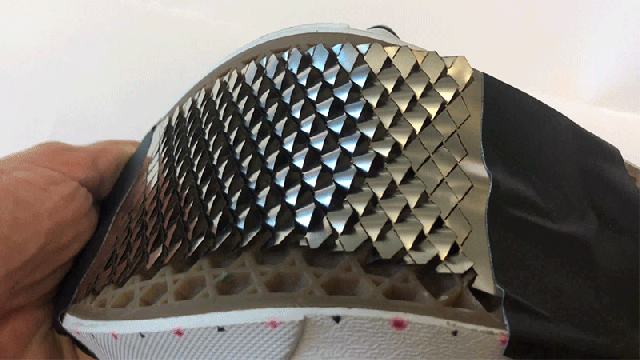Boots with a thick tread are a must-have accessory for safely traversing ice and snow in the winter, but slipping hazards can exist anywhere, especially for people with mobility challenges. Researchers at MIT and Harvard University have developed a new material that could radically improve the grip on the bottom of a shoe — without making it bulky or heavy like a snow boot.
Finding ways to stay safe and stable on slippery surfaces has long been a pursuit of companies known for making outdoor gear. Four years ago, Vibram demonstrated its Arctic Grip material that improved the traction of rubber-soled boots on smooth surfaces made slick with ice, but to date the innovation has only been available on boots and shoes designed for outdoor use, and it doesn’t provide any help on smooth tile floors or other indoor surfaces that also pose a slipping risk to some.
With this in mind, a group of researchers from MIT and Harvard University set out to find an alternate way to improve the grip of shoes, taking a mechanical approach instead of just tweaking a recipe for the rubber used in the soles. They were inspired by the Japanese art of intricate paper cutting known as kirigami, which involves making a pattern of small cuts in a rigid sheet to give it flexibility and malleability so that it can be shaped into three-dimensional structures. Most often the art, which is related to origami, is practiced with paper, but the researchers needed something more durable, so they turned to thin sheets of metal and plastic.
Their approach involved testing different designs with repeating patterns of spikes, curves, and even assorted shapes cut into the thin sheets that were then affixed to the bottom of shoes. The various sample materials remain flat while the wearer is standing, but when they start walking, the foot and shoe naturally bend, and the material morphs into a 3D structure with protruding spikes that provide extra grip. It’s not unlike stretching those rubber traction boosters covered in small metal spikes that can be attached to a pair of boots, but here the spikes only extend when they’re needed.
The researchers found that all of the kirigami designs increased traction by anywhere from 20 to 35 per cent on various types of shoes used on surfaces including wood, vinyl flooring, and even artificial turf — not just ice. But the standout was a pattern consisting of concave curves. What’s still to be determined is how to implement or incorporate the kirigami surfaces into footwear. It could be part of the shoe’s sole permanently, or something applied only when needed. There’s also the concern of how certain materials will affect floors; if kirigami materials are permanently integrated into the sole of a shoe, there’s a risk of shredding carpeting or leaving marks on wood floors. But the potential here for people who need extra stability on slippery surfaces is certainly exciting.
